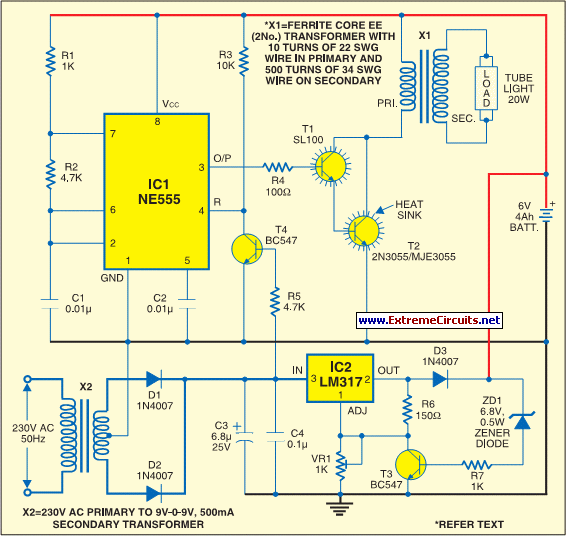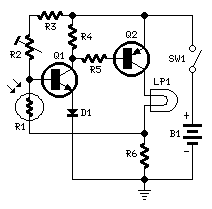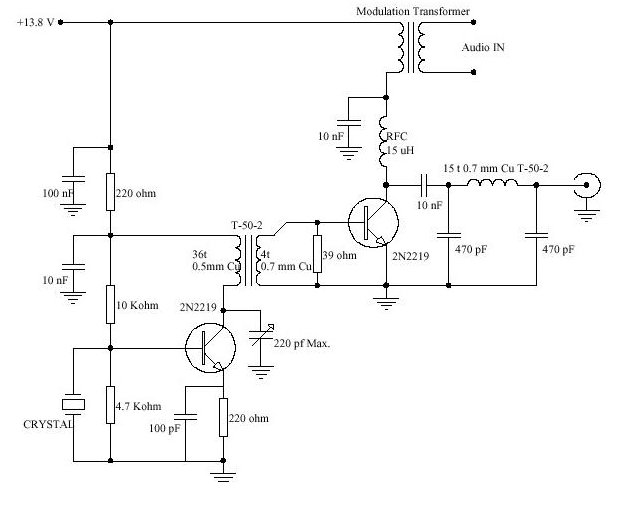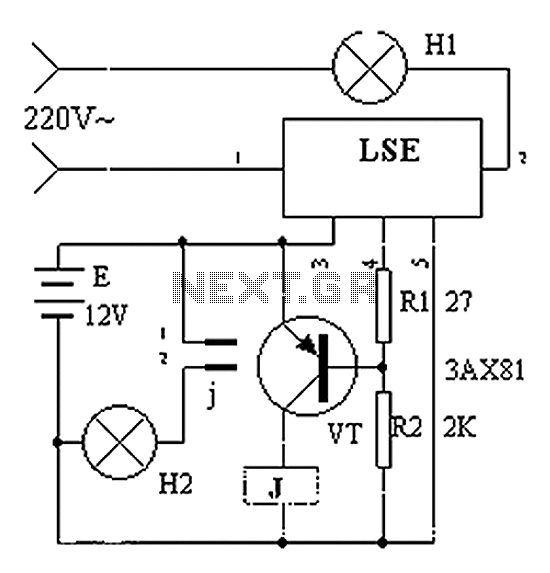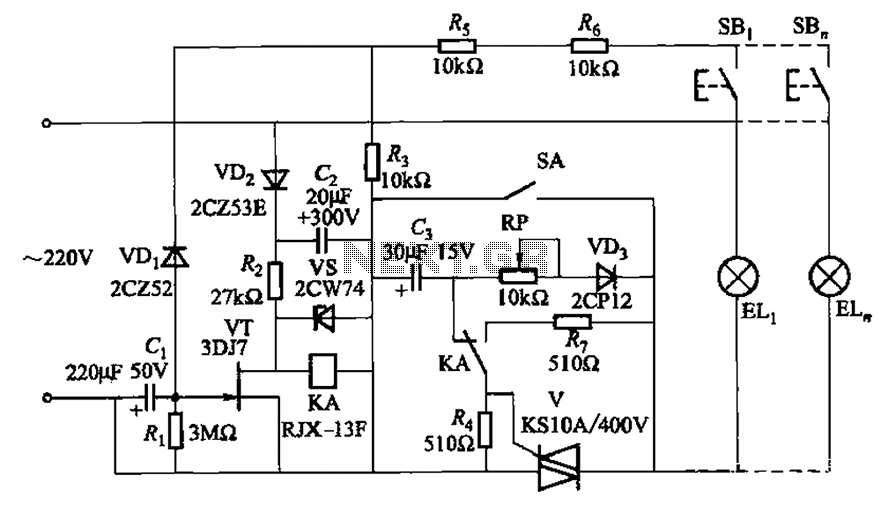
Light Dimmers Circuits
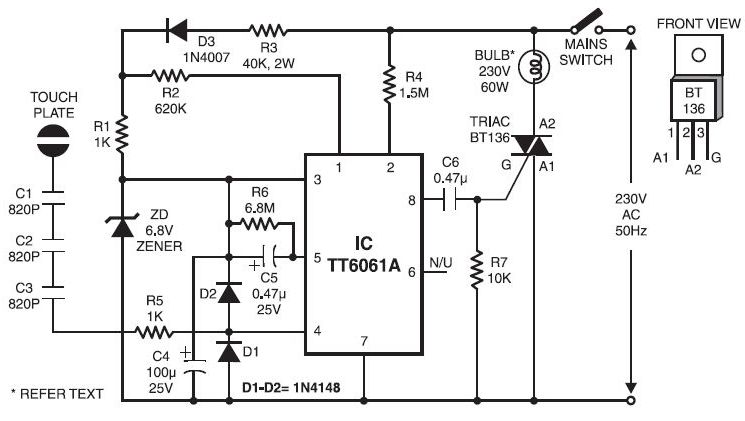
Typically, when a car door is closed, the dome light turns off immediately. This circuit allows the dome light to gradually fade in brightness before eventually turning off. An electronic transformer dims halogen lamps and is a straightforward device that can be improved with dimming control. The halogen light dimmer provides continuous control by injecting a constant current into the halogen lamp and regulating that current using pulse-width modulation (PWM). A light dimmer is utilized to adjust the brightness level of a lamp. In this application, a 555 timer is employed to manage the brightness of a low-voltage incandescent bulb rated up to 60 watts. The 555 timer is configured as a variable-cycle astable oscillator operating around 300 Hz. Additionally, a microcontroller-based multi-channel light dimmer is proposed, suitable for theatrical and other applications. This device accepts inputs from various interfaces, including RS232, DMX512 (theatrical lighting standard), RS485, or MIDI. It controls multiple lamps using AC power control, with the microcontroller firmware managing all functions, from decoding input protocols to timing the firing of power triacs for output. An automatic 12-volt light dimmer is also mentioned, capable of controlling up to 50 watts of halogen lamps to maintain a consistent light level in a room. The document is available in PDF format.
The described circuit features several key components and functionalities that enhance the control of lighting systems, particularly for halogen lamps and incandescent bulbs. The gradual fading of the dome light when a car door is closed is achieved through a timed circuit that utilizes capacitors and resistors to create a delay in the signal, allowing for a smooth transition in brightness. This not only enhances the aesthetic appeal but also serves practical purposes, such as providing illumination when entering or exiting the vehicle.
The electronic transformer operates efficiently by converting high voltage AC to a lower voltage suitable for halogen lamps, while also incorporating dimming capabilities. The PWM method allows for precise control of the lamp’s brightness by rapidly switching the power on and off, adjusting the average power delivered to the lamp based on the duty cycle. This method is advantageous as it minimizes heat generation compared to traditional resistive dimmers.
In the case of the 555 timer-based dimmer, its configuration as an astable oscillator allows it to generate a continuous pulse signal, which can be adjusted to control the brightness of the connected incandescent bulb. The frequency and duty cycle of the output signal can be tuned by varying the resistor and capacitor values, enabling versatile control over light output.
The microcontroller multi-channel light dimmer expands the scope of lighting control by integrating various communication protocols, allowing for sophisticated lighting setups commonly used in theatrical productions. This system can be programmed to respond to different input signals, coordinating multiple light sources for dynamic lighting effects. The use of triacs for AC power control facilitates efficient switching of the lamps, ensuring reliable operation while handling higher power loads.
The smart 12-volt light dimmer is designed to maintain a stable light level in a room, adjusting output based on ambient light conditions or user preferences. This feature enhances energy efficiency and user comfort, making it suitable for applications where consistent lighting is crucial.
Overall, these circuits represent a progression in lighting control technology, combining simplicity with advanced features to meet diverse user needs in automotive, residential, and theatrical environments. The documentation in PDF format provides further technical details and schematics for implementation.Usually when the car door is closed, the dome light just goes OFF. With this circuit, you can have our dome light fade slowly in brightness and finally go OFF. Electronic Transformer Dims halogen Lamp : 05/11/00 EDN-Design Ideas / (several circuits in PDF) Switched-mode power supply for a halogen lamp, commonly known a s an electronic transformer, is a clever and simple device which can be enhanced with dimming control Halogen Light Dimmer Provides infinite Control : 03/16/00 EDN-Design Ideas / PDF contains multiple circuits - scroll to find the one of interest / Dimmer works to inject a constant current into the halogen lamp and to regulate that current using pulse-width modulation (PWM) / PDF contains multiple circuits - scroll to find the one of interest according to a potentiometer-controlled input, or a0 to5V signal Low Voltage Light Dimmer : A light dimmer is a means of controlling the "brightness" level of a lamp, in this application we will use a555 Timer to control the brightness level of a low voltage incandescent bulb of up to 60-Watts. For the light dimmer to work the555 Timer is configured as a "variable cycle", astable oscillator running some where around300 Hz.
Microcontroller Multi Channel Light Dimmer: The project is a microprocessor-controlled multiple channel lighting dimmer, that could be used in theatrical and other applications. The device will accept input from a wide range of interfaces: RS232 input, DMX512 (theatrical lighting standard) or RS485, or a Musical Instrument Digital Interface (MIDI).
The device will control a number of lamps by using some form of AC power control. The firmware in the microcontroller will handle all functions, from decoding the protocol on either of the input interfaces through to Timing the firing of power triacs for the output. Smart 12 Volt Light Dimmer : This automatic dimmer will control up to50-Watts worth of halogen lamps in order to maintain a consistent light level in a room.
Document is in PDF format. 🔗 External reference
The described circuit features several key components and functionalities that enhance the control of lighting systems, particularly for halogen lamps and incandescent bulbs. The gradual fading of the dome light when a car door is closed is achieved through a timed circuit that utilizes capacitors and resistors to create a delay in the signal, allowing for a smooth transition in brightness. This not only enhances the aesthetic appeal but also serves practical purposes, such as providing illumination when entering or exiting the vehicle.
The electronic transformer operates efficiently by converting high voltage AC to a lower voltage suitable for halogen lamps, while also incorporating dimming capabilities. The PWM method allows for precise control of the lamp’s brightness by rapidly switching the power on and off, adjusting the average power delivered to the lamp based on the duty cycle. This method is advantageous as it minimizes heat generation compared to traditional resistive dimmers.
In the case of the 555 timer-based dimmer, its configuration as an astable oscillator allows it to generate a continuous pulse signal, which can be adjusted to control the brightness of the connected incandescent bulb. The frequency and duty cycle of the output signal can be tuned by varying the resistor and capacitor values, enabling versatile control over light output.
The microcontroller multi-channel light dimmer expands the scope of lighting control by integrating various communication protocols, allowing for sophisticated lighting setups commonly used in theatrical productions. This system can be programmed to respond to different input signals, coordinating multiple light sources for dynamic lighting effects. The use of triacs for AC power control facilitates efficient switching of the lamps, ensuring reliable operation while handling higher power loads.
The smart 12-volt light dimmer is designed to maintain a stable light level in a room, adjusting output based on ambient light conditions or user preferences. This feature enhances energy efficiency and user comfort, making it suitable for applications where consistent lighting is crucial.
Overall, these circuits represent a progression in lighting control technology, combining simplicity with advanced features to meet diverse user needs in automotive, residential, and theatrical environments. The documentation in PDF format provides further technical details and schematics for implementation.Usually when the car door is closed, the dome light just goes OFF. With this circuit, you can have our dome light fade slowly in brightness and finally go OFF. Electronic Transformer Dims halogen Lamp : 05/11/00 EDN-Design Ideas / (several circuits in PDF) Switched-mode power supply for a halogen lamp, commonly known a s an electronic transformer, is a clever and simple device which can be enhanced with dimming control Halogen Light Dimmer Provides infinite Control : 03/16/00 EDN-Design Ideas / PDF contains multiple circuits - scroll to find the one of interest / Dimmer works to inject a constant current into the halogen lamp and to regulate that current using pulse-width modulation (PWM) / PDF contains multiple circuits - scroll to find the one of interest according to a potentiometer-controlled input, or a0 to5V signal Low Voltage Light Dimmer : A light dimmer is a means of controlling the "brightness" level of a lamp, in this application we will use a555 Timer to control the brightness level of a low voltage incandescent bulb of up to 60-Watts. For the light dimmer to work the555 Timer is configured as a "variable cycle", astable oscillator running some where around300 Hz.
Microcontroller Multi Channel Light Dimmer: The project is a microprocessor-controlled multiple channel lighting dimmer, that could be used in theatrical and other applications. The device will accept input from a wide range of interfaces: RS232 input, DMX512 (theatrical lighting standard) or RS485, or a Musical Instrument Digital Interface (MIDI).
The device will control a number of lamps by using some form of AC power control. The firmware in the microcontroller will handle all functions, from decoding the protocol on either of the input interfaces through to Timing the firing of power triacs for the output. Smart 12 Volt Light Dimmer : This automatic dimmer will control up to50-Watts worth of halogen lamps in order to maintain a consistent light level in a room.
Document is in PDF format. 🔗 External reference
